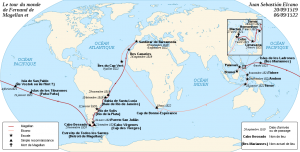20 September 2019: 500th Anniversary of the First Circumnavigation
On the 20th September 1519 Ferdinand Magellan set sail from the Spanish port of Sanlúcar de Barrameda with a fleet of 5 ships, the Armada de Molucca, in a quest to sail westwards to the Spice Islands. The expedition ended on 6 September 1522, when the only surviving ship, the Victoria, arrived back in Spain – without Magellan. This year is the 500th anniversary of the start of what became the first circumnavigation of the world.
Published 6 years ago


- The route of Magellan’s ciurcumnavigation. © Sémhur / Wikimedia Commons
Ferdinand Magellan had spent many years fighting for the king of Spain in India and Morocco. Following an altercation there he was unfairly tried and acquitted of treason and, as a result, left the service of King Manuel in 1517 and sought out the protection of the Spanish King, Charles 1. He brought with him invaluable navigational skills, secrets, and maps known only to the Portuguese. He persuaded the king to finance and mount an expedition to the Spice Islands, also known as the Moluccas.
The fleet was made up of the Trinidad, captained by Magellan together with the San Antonio, the Concepción, Santiago and Victoria with a total crew of about 260. From the very beginning, the fleet encountered problems. After being pursued by two fleets of Portuguese ships sent to arrest him, Magellan’s armada experienced a series of storms in the Atlantic, and the captain of the San Antonio attempted a mutiny. It was unsuccessful and he was relieved of his command but allowed to stay with the fleet.
Failing to find a passage through what became the Strait of Magellan. The fleet wintered in St Julian in Patagonia. It was here that anther mutiny was attempted involving three of the ship’s captains. It was eventually quelled but nearly fifty mutineers were either executed, marooned or sentenced to periods of hard labor.
The first ship was lost in August 1520 when the Santiago, which has been exploring the coast of the south of St. Julian ran aground at Santa Cruz. The second a few months later when the San Antonio deserted the fleet when they were transiting what is now called the Strait of Magellan. The crew of the San Antonio had successfully mutinied, returned to Seville and remarkably avoided any charges.
During the crossing of the Pacific Ocean, now with a complement of 200, 29 seamen died of scurvy. They reached the Philippines in April 1521 and Magellan immediately declared them a possession of Spain. It was here that Magellan was killed when he led a force of about 60 armed men, on the island of Mactan, against the natives who were resisted attempts to convert them to Christianity. This was followed by a massacre of 27 men, mostly officers, on the island of Cebu after they had been invited to a feast on the island.
There were not enough sailors left to man three ships so the Concepción was set on fire and scuttled. The Trinidad and Victoria then spent six months in search of the spice islands (the Moluccas) eventually reaching them in November 1521. By December the ships had a full cargo of cloves. The Victoria continued westwards back to Europe whilst the Trinidad, which need extensive repairs planned to head eastwards back through the Pacific. However, she was captured by the Portuguese and lost in a storm whilst at anchor.
After rounding the Cape of Good Hope, losing 20 men from starvation and abandoning 13 more, Captain Juan Sebastián Elcano arrived back at Sanlúcar de Barrameda with the Victoria on 6 September 1522.
Of the 270 men that set sail only 18 returned.
Related Content:
Over the Edge of the World- Magellan’s Terrifying Circumnavigation of the Globe
By Laurance Bergreen – Book review
Who First Circled the Globe? Not Magellan, Spain Wants You to Know – New York Times


